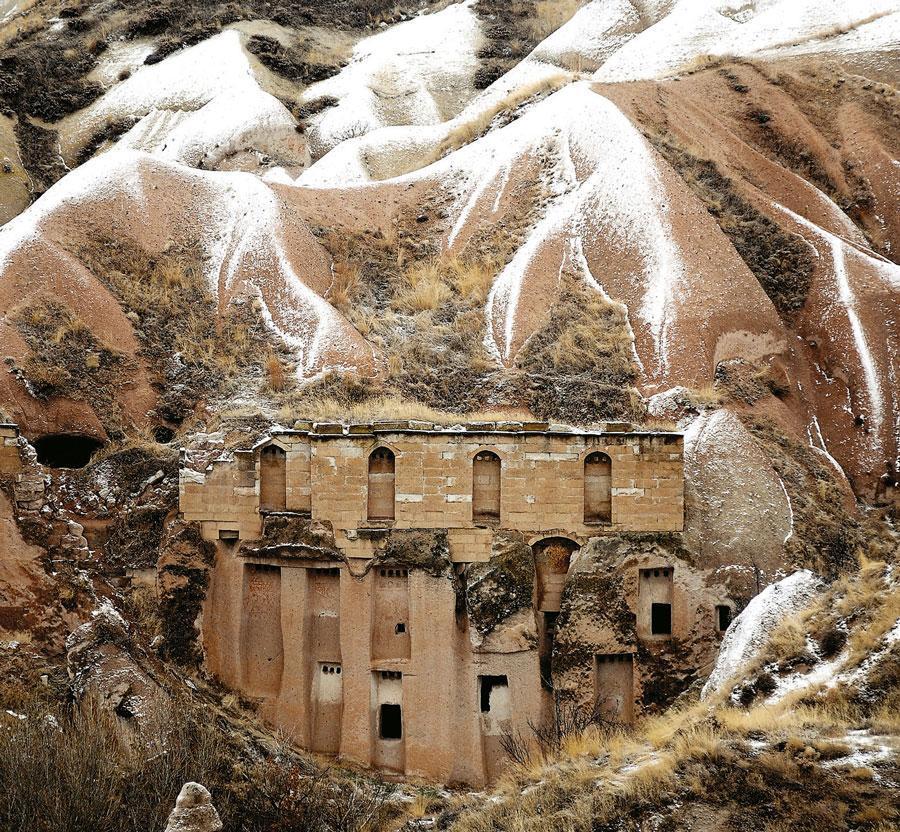Cappadocia: A winter wonderland
Melih Uslu

Fairy chimneys that take on an eerie quality in the winter sun. Volcanic valleys harboring vestiges of ancient civilizations. Hiking trails as smooth as Tartan track. Mysterious tunnels and fresh oxygen-rich air. Set in a volcanic triangle of snow-capped peaks, Cappadocia’s fairytale valleys present landscapes of extraordinary beauty in winter.
Like a Stone Age settlement on the slopes of a giant fairy chimney, Uçhisar is the region’s natural fortress. This charming village only 10 kilometers from Nevşehir is famous for its antique shops and boutique hotels. Next to it stretches the Valley of Pigeons, a long, deep canyon that intrigues with its pigeon nests carved in the rocks. This mysterious valley sheltering 8th and 9th century rock churches is laced with natural tunnels carved out by flowing streams.
Easily negotiable by man and horse, the tunnels make ideal trails for photographers and hiking enthusiasts. You can get a bird’s-eye view of the region’s most stunning valleys on the close to 3-kilometer-long Uçhisar-Göreme road. The best of their efforts can still be seen today in the Göreme Open Air Museum, one of the highlights of any Cappadocia tour. Scattered through this museum on the UNESCO World Cultural Heritage List are numerous monasteries carved in the rock including a monks’ refectory, burial chambers and a wine cellar. The pigments in the murals inside the rock-cut churches, the newest of which dates to the 12th century, are as vivid as if they were painted yesterday. One of Cappadocia’s oldest settlements, Avanos is another must-see. As the giant monument at the entrance announces, this town has been a center of pottery making since the time of the Hittites.
Labyrinth caves and tunnels
Cappadocian valleys are the result of long-ago volcanic eruptions that slathered the scenery with a thick coating of tuff, which the ensuing centuries than eroded into deep gullies or carved into fantastically-shaped rock formations. Later came the pickaxe and shovel-wielding humans who chipped away at the rocks to make homes for themselves and stables for their animals.
In troubled times they burrowed down into the soil, creating the underground cities, labyrinthine networks of caves and tunnels. When times were more settled they took out their paintbrushes and applied colorful frescoes to the walls of rock-cut churches, inside-out structures that mimicked the architecture of more conventional churches. On the other hand, you can stop at one of the many workshops here on the banks of the Kızılırmak River and try fashioning a vessel yourself with the help of an expert.
Meanwhile, one of the local architectural masterpieces is Saruhan, a 13th-century Seljuk caravanserai. Avanos’s next door neighbor Çavuşin with its rock-cut houses and historic temples will offer you pleasant hours of sightseeing. And Kızılçukur Valley further along the road through Çavuşin is a favorite spot for Cappadocia sunset and full moon outings. Paşabağı Valley with its exceptionally beautiful fairy chimneys and Zelve, famous for its open air museum, are two more major sightseeing venues in the vicinity. But now the traditional way of life is dangling by a thread.
The once damp and undesirable cave houses in which generations of Cappadocians had grown up are increasingly being turned into bijou boutique hotels. All over Cappadocia, from remote villages like Cemil, Taşkınpaşa and Şahinefendi to more central ones such as Uçhisar, Çavuşin and Ürgüp, visitors can now stay in cave hotels designed to let them try on the troglodytic lifestyle for themselves.
Graceful mansions
The region’s oldest and most elegant stone houses meanwhile are at Sinasos, five kilometers from Uçhisar. You won’t be able to take your eyes off these centuries-old structures as you tour the historic settlement, known today as Mustafapaşa. Attracting notice recently for its comfortable small hotels, Sinasos’ graceful mansions, garden houses and local cuisine will intrigue you. A little further on, Gomeda Valley, with its magnificent natural setting reminiscent of a film set, is another must on your sightseeing list.
Like Ihlara, the area’s geological treasure, this valley promises hours of enjoyable hiking. And now for perhaps the most exciting part of any Cappadocia tour. We decide to look for some of the many underground cities carved in the soft tufa stone, of which there are some 200 large and small in the area.
The largest is Derinkuyu, said to have at one time sheltered some 20,000 people. Two more among the underground cities, most of which are open to visitors, are Özkonak north of Avanos and Kaymaklı, 19 kilometers south of Nevşehir.
In sum, there is no shortage of places to see in the region, so be sure to budget your time and energy. What else? Well, taking long strolls among the shapely, snow-covered fairy chimneys, staying overnight in a real cave house carved out by human hands, gazing at the stars from a deserted terrace, eating breakfast as dawn stains the valleys crimson, hunting for traces of human settlement in the miraculous labyrinths of the underground cities. Reasons are rife for you to delve into the soul of Cappadocia and become passionately attached.
















